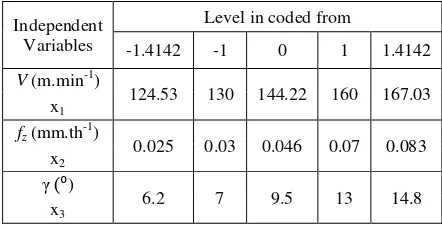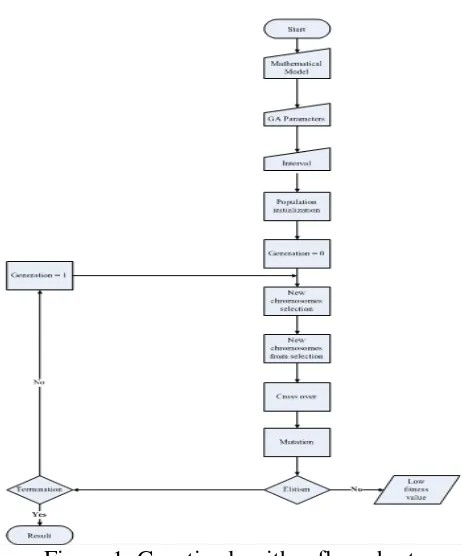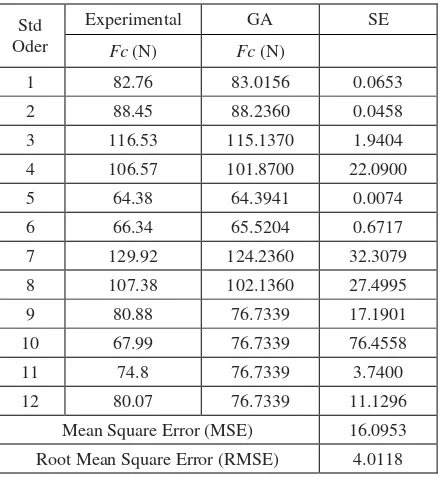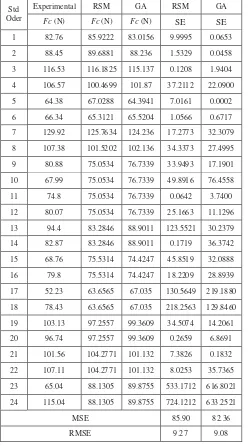SEMINAR NASIONAL TEKNIK MESIN 4
”MENINGKATKAN KERJASAMA PERGURUAN TINGGI DAN INDUSTRI
MELALUI RISET DAN INOVASI DI BIDANG TEKNIK MESIN”
Jl.Siwalankerto 121-131
Surabaya 60236Telp.
031-78009075, Fax. 031-8417658Email : sntm.petra@gmail.com; Website : http://www.petra.ac.id
! "
#
"$
%
"
!
&
'
" % (
Bpk. A. S. Mohruni
Universitas Sriwijaya
) *
+
, ! !
" !
-
! . * %
!!
!
% *
/ %
“Utilization of Genetic Algorithm for Cutting Force Optimization when Machining Ti-6Al-4V using TiAlN coated End Mills”
% . !
! % " %
/ !
%
"
!
%
/ %
" %
. * !
%
**
!
" !
0$
1 , 2
+ ** 3
%
4
. $
, ! !
" !
"
,
"
!
*! "
**
) *
$
!
" 5 ! &
%. 5 ".'
" / ! 67
!
6 %
&
" '
$
5 ". . * % " % !
$" 8*
$5
. 9"8" $" $ 5$ %
3
, ! , !
.
&:%
% " / *
% !
$" 8*
$5
. 9"8" $" $ 5$ %
% 7 ; !
3 20< => 0
:'
!
-
!
. * % ! %
. !
" %
**
%
% ! % 5 ! %
% *$
)
!
"
!
+
!
"
%
" "
.
! /
. $
Ketua Panitia Seminar Nasional
Fandi Dwiputra Suprianto, ST, MSc
UTILIZATION OF GENETIC ALGORITHM FOR CUTTING FORCE OPTIMIZATION
WHEN MACHINING Ti-6Al-4V USING TIALN COATED END MILLS
A.S. Mohruni
1, S. Sharif
2, M.Y. Noordin
2, A. Ardiansyah
11
Mechanical Engineering Department, Sriwijaya University, Indralaya, 30662 OI-Indonesia
Phone: +62-711-580062 Fax: +62-711-580741 E-mail : mohrunias@yahoo.com, mohrunias@unsri.ac.id
2
Faculty of Mechanical Engineering, Universiti Teknologi Malaysia, 81310-UTM Skudai, optimum cutting conditions such as cutting speed (V), feed per tooth (fz), and radial rake angle (γo). The results were
Cutting Force, End Milling, Titanium Alloys, Genetic Algorithm, Response Surface Methodology
1.
INTRODUCTION
Titanium alloys are used widely in the aerospace, chemical and ship building industry because of their superior mechanical properties, heat and corrosions resistance. Titanium alloy, however are materials that are extremely difficult to machine [1].
Due to their low machinability of the alloy under study, selecting the machining conditions and parameters is crucial. According to the past reports, the range of feeds and cutting speeds which provide a satisfactory tool performance is very limited. On the other hand, adequate tool, coating, geometry and cutting flow materials should be used [2].
For selecting the optimum cutting conditions in machining processes was initiated using Response Surface Methodology by [3], followed by [4]-[6] and recently was began to explore the very limited study using non-conventional algorithm in by [7]-[9]. None of previous studies employed genetic algorithm for finding the optimum cutting conditions in machining of aerospace materials. Therefore the aim of this study is to contribute in providing such lack of information.
2.
EXPERIMENTAL SET-UP
Based on [6] experiment, a CNC MAHO 700S machining centre was used for experimentation, while side-milling process was conducted with a constant axial depth of cut aa 5 mm and radial depth of cut ae 2 mm under flood coolant with a 6% concentration.
The reference workpiece material of Ti-6Al-4V, which was a rectangular block of 110 mm x 55 mm x 150 mm, was used for cutting force measurements.
The end mill was clamped to the tool holder with a constant 22 mm overhang. The TiAlN coated grade K-30 solid carbide end milling with different radial rake angle according to design of experiment, were used in the experiments. To avoid the influence of tool wear, the forces data (Fx, Fy, Fz) were recorded during the initial cut when
the end mill was still new without wear. The recording of cutting force was carried out using multi component force measuring system consisting of the following elements:
A 3-component dynamometer comprising of basic unit (Kistler, Type 9265B) and screwed-on working adapter for milling (Kistler, Type 9443B)
A multi channel charge amplifier (Kistler, Type 5019A)
A data acquisition system consisting of a personal computer (PC) equipped with an A/D board as well as the DynoWare software (Kistler, Type 2825 D1-2, version 2.31)
Machining condition used in this exp
eriment :
Cutting speed V : 130 - 160 m/min.
Feed fz : 0,03 - 0,07 mm/tooth. Radial rake angle γ : 7 - 13o.
Machining condition coded by equation (1)
:
(1)
Table 1: Levels of Independent Variables for Ti-6Al-4V.
Experimental results from Design of Experiment (DOE) showed by Table 2. From the result known that the most significant factor that affected the cutting force was factor feed, followed by interaction feed and radial rake angle, interaction speed and feed and lastly factor cutting speed [10].
Table 2: Cutting Force Fc when using TiAlN Coated Carbide Tools.
Optimization in this study is to find minimum cutting force using Genetic Algorithm method. With this method hopefully optimum cutting condition can investigated better than RSM method from the previous research. GA is the algorithm based on the biology [11]. Generally there are eight components of GA: coding scheme, fitness value, parent selection, crossover, mutation, elitism, generational replacement, and termination criteria [12]. In this study MATLAB software used to apply GA, because in this software there are many mathematical operations that can make this optimization easier to conduct [13].
According to [6] mathematical model used for optimizing the cutting force in this study:
3FI Cutting Force Model
y = 4.5285 – 0.02293x1 + 0.21403x2– 0.0528x3–
0.04705x1x2 + 0.08189x2x3 (2)
1st order CCD Cutting Force Model
y1 = 4.4615 - 0.02293x1 + 0.21403 x2 - 0.0528 x3 (3)
Both models are valid for end milling of titanium alloy, Ti6Al4V using TiAlN coated carbide tools under wet conditions with the following range of respective cutting speed (V, fz, and γo) : 130 ≤ V≤ 160 m/min; 0.03 ≤ fz≤ 0.07 mm/teeth; 7 ≤ γo≤ 13 (o). Experimental data used o validate the optimization result data are no. 1 to no. 12.
2nd order CCD Cutting Force Model conditions with the following range of respective cutting speed (V, fz, and γo) : 124.53 ≤ V≤ 167.03 m/min; 0.025 ≤fz
≤ 0.083 mm/teeth; 6.2 ≤ γo ≤ 14.8 (o) Experimental data used o validate the optimization result data are no. 1 to no. 24.
There are six parameters that must be determined in GA method [13]:
Population size = 80
Maximum generation = 10
Crossover probability (Pc) = 0.8
Mutation probability (Pm) = 0.03
Elitism probability (Pe) = 0.5
Figure 1: Genetic algorithm flow chart.
4.
RESULTS AND DISCUSSION
In this study 3 mathematical models of cutting force, such as ; 3FI Cutting Force Model, 1st order CCD Cutting
Force Model and 2nd order CCD Cutting Force Model,
were validated using experimental data.
Table 3: RSM validation test results for 3F1 Cutting Force Model about experimental results to std. order 1-12.
Std
Mean Square Error (MSE) 104.6247
Root Mean Square Error (RMSE) 10.2286
Table 4: RSM validation test results for 1st order CCD Cutting Force Model about experimental results
to std. order 1-12.
Mean Square Error (MSE) 136.9764
Root Mean Square Error (RMSE) 11.7037
Table 5: RSM validation test results for 2nd order CCD Cutting Force Model about experimental results
to std. order 1-12.
Mean Square Error (MSE) 18.1352
Table 6: RSM validation test results for 2nd order CCD Cutting Force Model about experimental results
to std order 13-24.
Mean Square Error (MSE) 153.6744
Root Mean Square Error (RMSE) 12.3965
Based on validation test results above, it is proven that the
2nd order CCD Cutting Force Model is the most accurate
model compared to 1st order CCD Cutting Force Model and
3FI Cutting Force Model. Because of that, the 2nd order
CCD Cutting Force Model was used to optimize cutting
force.
Table 7 and 8 show the validation test to RSM and GA method using 2nd order CCD Cutting Force Model
Table 7: Validation test results to GA method for 2nd order CCD Cutting Force Model about experimental results
to std order 1-12.
Mean Square Error (MSE) 16.0953
Root Mean Square Error (RMSE) 4.0118
Table 8: Validation test results to GA method for 2nd order CCD Cutting Force Model about experimental results
to std order 13-24.
Mean Square Error (MSE) 148.6398
Root Mean Square Error (RMSE) 12.1918
Optimization of cutting force using RSM and GA method seen by following table.
Table 9: Optimization results using RSM for 2nd order CCD Cutting Force Model
Table 10: Optimization results using GA for 2nd order CCD Cutting Force Model
Fc minimum using the 2nd order CCD Cutting Force Model according to GA is 64.3941 N and RSM is 62.0413 N.
Table 11: Validation test results method RSM and GA for 2nd order CCD Cutting Force Model about experimental results
to std order 1-24.
Although the optimization using RSM and GA have shown different results, they are still in tolerance, which is shown in Figure 2.
Figure 2: Cutting force results using GA and RSM compare to experimental results when end milling Ti-6Al-4V.
5.
CONCLUSIONS
1) Overall performance of optimization using genetic algorithm showed better results than those using response surface methodology. RMSE accuracy of GA is about 9.08 compared to accuracy of RSM = 9.27. 2) In case of finding the minimum cutting force value,
genetic algorithm delivered better results than that using response surface methodology (RSM-result Fc = 67.0288 N, while GA-result Fc= 64.3941 N).
3) Genetic algorithm can accomplish the optimization in machining of aerospace materials with adequate accuracy, which is required in industry.
4) The optimum cutting condition found using genetic algorithm is as follows: cutting speeds V = 136.976 m/min, feed per tooth fz = 0.03028mm/tooth and radial
rake angle γo = 12.9947o.
REFERENCES
[1] Z.A. Zoya and R. Krishnamurty, “The Performance of
CBN Tools in the Machining of Titanium Alloys”, Journal of Materials Processing Tecnology, Vol. 100, pp. 80-86, 2000.
[2] L.N. Lopez de lacalle, J. Perez, J.I. Llorente, J.A. Sanchez, “Advanced Cutting Conditions for the Milling of Aeronautical Alloys”, Journal of Materials Processing Technology, Vol. 100, pp. 1-11, 2000.
[3] K.C. Lo and N.N.S. Chen, “Prediction of Tool Life in
Hot Machining of Alloy Steel”, International Journal for Production Research, Vol. 15, pp. 47-63, 1977. [4] M. Alauddin, M.A. El-Baradie, M.S.J. Hashmi,
“Modeling of Cutting Force in End Milling Inconel 718”, Journal of Materials Processing Technology, Vol. 58, pp. 100-108, 1996.
[5] M. Alauddin, M.A. Mazid, M.A. El-Baradie, M.S.J. Hashmi, “Cutting Force in End Milling Inconel 718”, Journal of Materials Processing Technology, Vol. 77, pp. 153-159, 1998.
[6] A.S. Mohruni, S. Sharif, and M.Y. Noordin, “Mathematical Modeling of Cutting Force in End Milling Titanium Ti-6Al-4V using TiAlN Coated
Carbide Tools”, Proceedings of International
Conference on Mechanical & Manufacturing Engineering (ICME2008), ISBN: 97-98-2963-59-2, Johor Bahru, 21-23 May, MFG ID 0394, 2008.
[7] N. Baskar, P. Asokan, R. Saravanan, G. Prabhaharan, “Optimization of Machining Parameters for Milling Operations Using Non-Conventional Methods”, International Journal of Advanced Manufacturing Technology, Vol. 25, pp. 1078-1088, 2005.
[8] N.S.K. Reddy and P.V. Rao, “A Genetic Algorithm
Approach for Optimization of Surface Roughness prediction Model in Dry Milling”, Machining Science and Technology, Vol. 9, pp. 63-84, 2005.
[9] N.K. Jain, V.K. Jain, K. Deb, “Optimization of process
Journal of Machine Tools & Manufacture, Vol. 47, pp. 900-919, 2007.
[10]A.S. Mohruni, S. Sharif, M.Y. Noordin, “Cutting Force
Prediction Models in End milling Titanium Alloy Ti-6Al-4V”, In Proceeding of 1st Regional Postgraduate Conference on Engineering and Science (RPCES2006), Johor Bahru, 26-27 July, ISSN: 1823-3287, pp. 337-342, 2006.
[11]S. Kusumadewi, “Artificial Intelligence (Teknik and Aplikasi)”, Graha Ilmu, Yogyakarta, Indonesia, 2003.
[12]Suyanto, “Artificial Intelligence, Informatika, Bandung, Indonesia, 2007.
[13]Suyanto, “Algoritma Genetika dalam MATLAB”,



